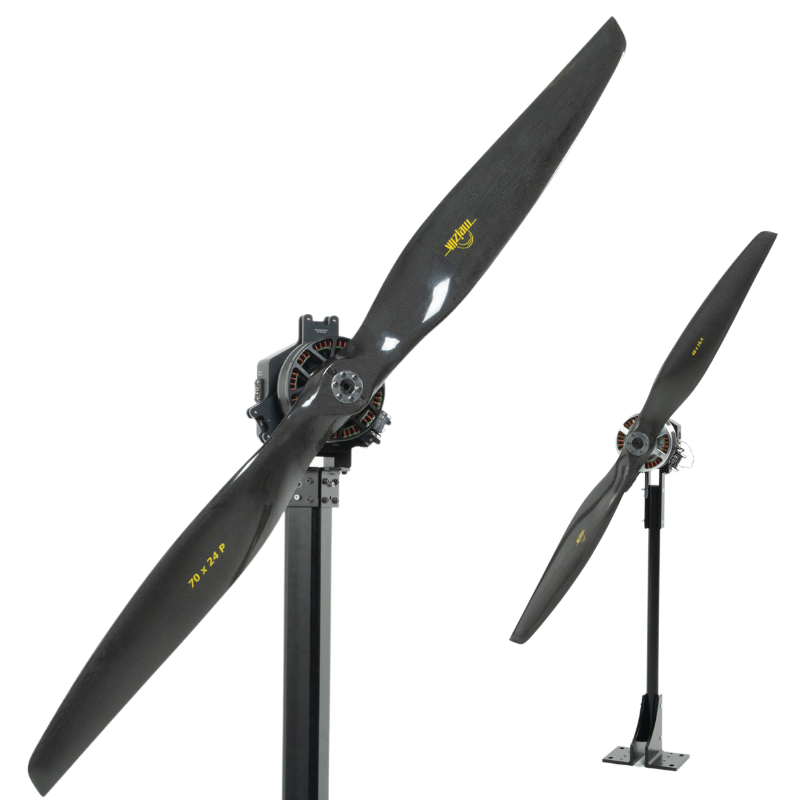By Lauren Nagel
Propeller balancing is essential for optimizing UAV performance, reliability, and longevity. Imbalanced propellers generate excessive vibration, leading to reduced thrust efficiency, increased noise, and accelerated wear on bearings and sensors.
Propellers can be balanced in one of three ways: statically, dynamically, and aerodynamically.
Static and dynamic balancing consist of adding weights to the propeller to achieve equal mass across the prop when at rest (static balancing) or at operating RPM (dynamic balancing). In contrast, aerodynamic balancing focuses on achieving blades with equal thrust generation, by adjusting the physical properties of the blades, often called tracking.
This article will discuss static and dynamic balancing, which should be performed before aerodynamic balancing.
If you're looking for a more in-depth comparison of both techniques, check out our White Paper on Static and Dynamic Propeller Balancing Techniques for Drones.
Table of Contents:
-
Why Propeller Balancing is Important
-
Static Balancing Method
-
Dynamic Balancing Method
1. Why Propeller Balancing is Important
Imbalanced propellers are a common cause of unwanted vibrations in drones. These vibrations can cause various issues, including increased wear on bearings and flight controllers, higher noise levels, and reduced stability during flight. By balancing the propeller, these vibrations are minimized, leading to smoother flights, better flight controller performance, and increased propeller lifespan.
While many off-the-shelf UAVs come with pre-balanced rotors that meet ISO standards, larger or in-house-built UAVs may require propeller balancing to mitigate the impacts of imbalance.
For more information, check out our white paper on theConsequences of Imbalanced Propellers on UAV Performance.

Figure 1: Propellers on a hexacopter drone
2. Static Balancing: A Simple Method for Smaller UAVs
Static balancing is a straightforward and affordable method for balancing propellers, typically used for non-commercial UAVs. This method involves mounting the propeller on a stationary stand and making adjustments until the propeller is visibly balanced.
How It Works:
To perform static balancing, the propeller is mounted on a balancer, which provides a low-friction pivot point, most often via magnets. This setup allows the propeller to rotate slightly. If one blade tends to drop, it is likely heavier than the other. Material can then be added or removed from the blade to achieve balance.
For tips on technique, check out our article on How to Add and Remove Material from Drone Propellers.
You’ll know the propeller is well balanced when you can place it in any position and it will stay put.

Figure 2: Using tape to balance a drone propeller statically (Servo Magazine)
Methods for Adding and Removing Material:
-
Adding Material: Materials like clear paint, glue, nail polish, adhesive tape, or small screws can be applied to the blade to adjust its weight.
-
Removing Material: Sanding, trimming, or drilling holes in the propeller can reduce weight. Sanding is typically done on the underside of the blade, while trimming is done on the trailing edge or tips to minimize aerodynamic effects.
Advantages of Static Balancing:
-
Cost-Effective: Static balancing equipment is less expensive compared to dynamic systems.
-
Ease of Use: It is simple to learn and perform, making it an excellent option for hobbyists.
-
Quick Setup: Once the equipment is in place, balancing can be done relatively quickly.
Limitations:
-
Accuracy: Static balancing is less precise than dynamic balancing, and no G value is generated to measure balance.
-
Manual Work: The balancing process is more hands-on, which can lead to variations in results, especially with complex propellers like foldable props.
3. Dynamic Balancing: Precision for Commercial UAVs
Dynamic balancing is the preferred method for commercial UAV developers and operators. Unlike static balancing, dynamic balancing measures the propeller’s vibration while it is rotating, allowing for a balance that is more relevant to operating conditions.
How It Works:
Dynamic balancing involves mounting the motor and propeller on a test stand with sensors to measure RPM and vibration. Tyto Robotics’Flight Stand is a good example of a test stand with built-in ISO-compliant propeller balancing capabilities. Software is then used to analyze the data and provide instructions for adding or removing material to correct the imbalance.

Figure 3: Dynamic propeller balancing using tape corrections
Steps for Dynamic Balancing:
-
Setup: Mount the motor and propeller on a test stand and connect the RPM sensor.
-
Enter Rotor Properties: Input the rotor’s mass, RPM, and desired balance grade into the balancing software.
-
Initial Test: Perform a test spin and allow the system to capture a base reading.
-
Apply Calibration Weight: The software will tell you how much material to add (e.g., tape, glue) to complete a calibration reading.
-
Apply Correction Weight:The software will tell you how much material to add to achieve a passing balance quality grade, most often < G 6.3.
-
Final Result: After a third spin, the software will confirm if the balance meets the desired grade. If necessary, additional corrections will be recommended.

Figure 4: Flight Stand software dynamic propeller balancing GUI
Advantages of Dynamic Balancing:
-
Precision: Dynamic balancing provides highly accurate results, making it ideal for professional applications where the consequences of imbalance are significant.
-
Standard Compliance: Dynamic systems can measure balance according to drone industry balancing standards, such as ISO 21940-11:2016.
-
Speed: Automated systems make the process quick, often taking less than five minutes per propeller.
Limitations:
-
Cost: The equipment required for dynamic balancing is more expensive than static setups.
-
Complexity: Some technical knowledge is needed to operate dynamic balancing systems, especially in determining variables like target RPM and G value.
Conclusion
Both static and dynamic balancing methods have their place in the world of drone development. For smaller, non-commercial drones, static balancing is a cost-effective and simple solution, while dynamic balancing is the go-to method for commercial developers who require precision and compliance with industry standards.
To learn more, check out our in-depth White Paper onPropeller Balancing Techniques:
Download White Paper




 Back to Blog
Back to Blog


Leave a comment